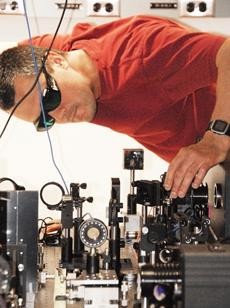Anyone who has played with a laser pointer knows a laser shoots a beam of light in a straight line. But UA researchers have managed to make a laser beam curve.
“”We showed that, essentially, a short pulse laser beam can curve,”” said Pavel Polynkin, an associate research professor in Optical Sciences. “”So it’s a lot of power but for a very short time. It’s essentially strong enough to ionize, break modules of air as it modulates.””
The curved laser has implications for particle acceleration, lightning control, remote spectroscopy and even bomb control.
According to Jerome Moloney, the principal investigator on the project and professor for the College of Mathematics and the College of Optical Sciences, a laser beam has been curved before, but they expanded on the research.
“”Our breakthrough was the observation of these bent light channels at extreme intensities where the light is so intense that it breaks down the oxygen and nitrogen molecules of air to form a curved plasma channel,”” Moloney wrote in an e-mail from Ireland.
The researchers did not invent a laser, though. “”What we do, we modify the beam somewhat,”” Polynkin said.
Modifying the beam profile can be likened to how projection televisions work, Polynkin said.
“”The lamp is passed through a spatial light monitor, inch by inch metrics. Depending on what kind of pattern, you see different images on the screen,”” he said. “”Instead of a lamp, we use a laser.””
Such a discovery holds implications for various breakthroughs in the future, Polynkin said.
The U.S. Military might be able to use the technology to enhance their ability to control bombs, Polynkin said.
“”You don’t know whether it’s a bomb or not, you take your laser and shoot it into the bomb,”” Polynkin said, “”It acts for such a short time … the energy in this pulse is not sufficient to blow up this bomb. But it will evaporate a small piece of this bomb.””
Military members would be able to see if the vapor has trace amounts of explosives in it, Polynkin said.
“”Without actually touching something, you could tell at a distance, without actually blowing it up,”” he said.
“”This technique is actually being pursued as a viable analysis tool for military,”” Polynkin said, adding that they will “”have to wait for this laser system to be more compact.””
Funding from the U.S. Air Force Office for Scientific Research helped lead to the discovery by enabling the researchers “”to build a world-class leading edge research program at the UA in the areas of Applied Mathematics that focus on nonlinear optics,”” Moloney said.
In addition to particle acceleration and remote spectroscopy, the laser might be used for lightning control, Polynkin said.
“”So essentially what people would do, shoot this laser pulse in the sky,”” he said, “”which creates a preferential path for the lightning. Instead of discharging randomly … you can essentially create a straight-charged channel for the lightning to go through.””
Moloney said this discovery has increased the program’s reputation.
“”We have a long history as the leading researchers worldwide in the theory and prediction of the behavior of these extreme ultra-short pulses as they propagate in the atmosphere and in condensed media,”” Moloney said. “”This has generated great interest worldwide and there have been a rash of articles interpreting our discovery.””









